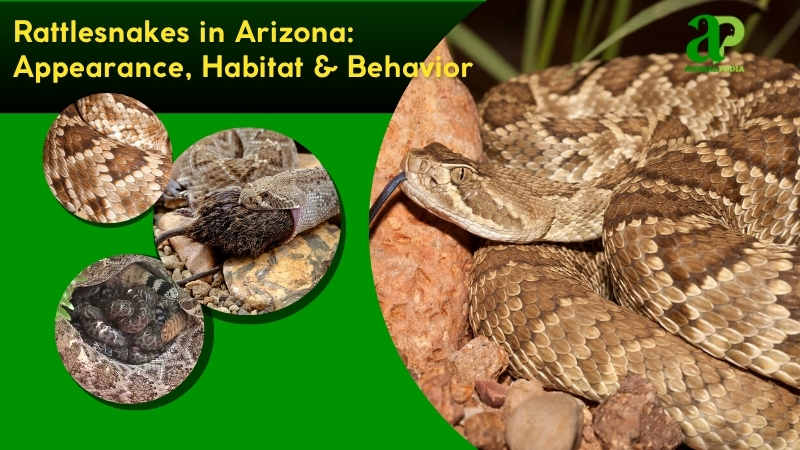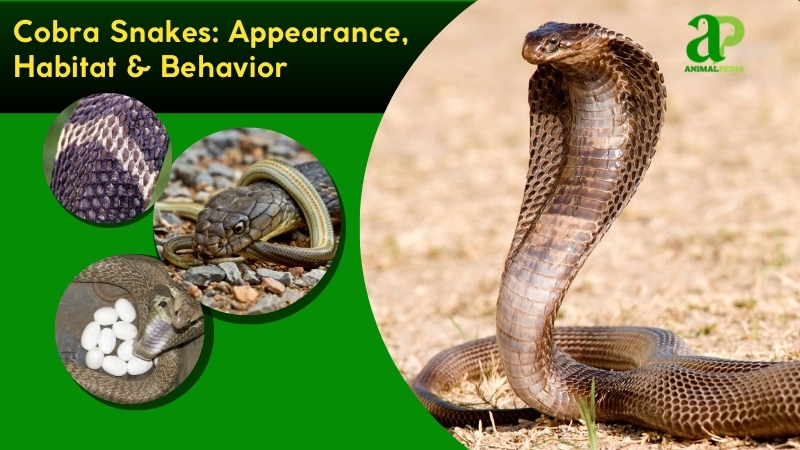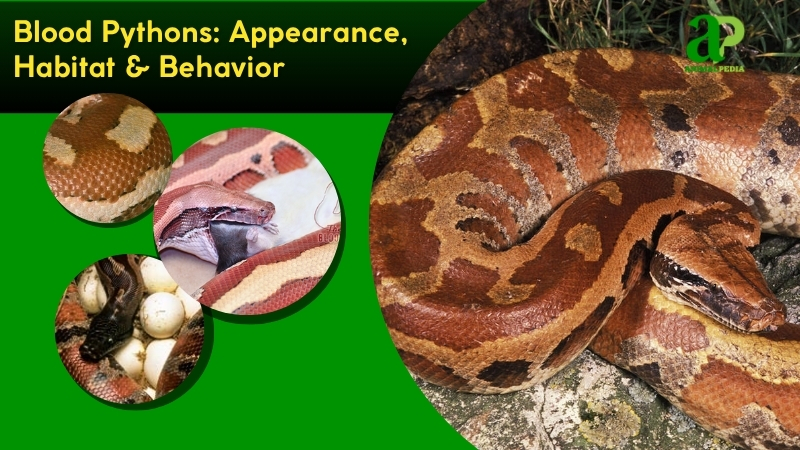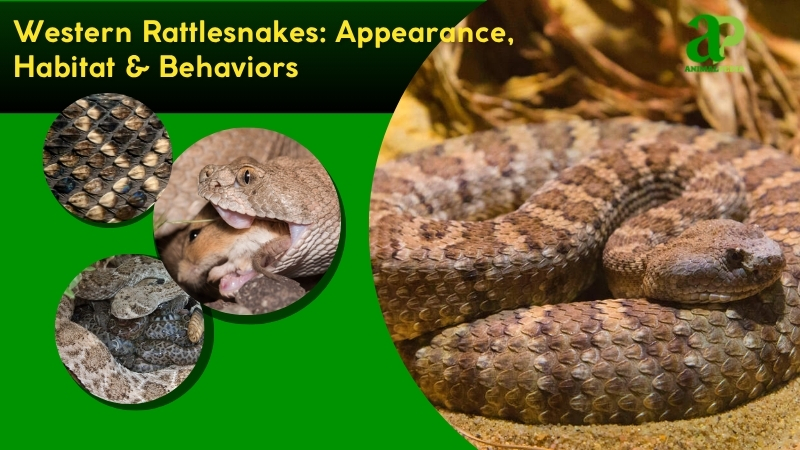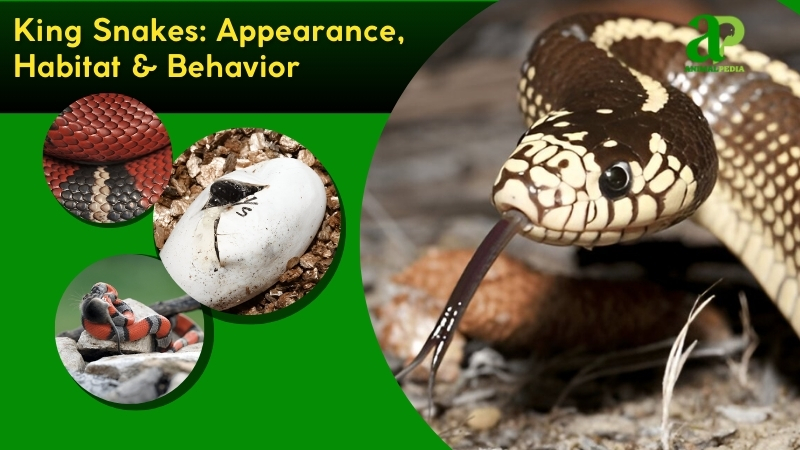Garter snakes are slender, agile reptiles distinguished by vibrant longitudinal stripes in yellow, green, or red against dark brown or black backgrounds. Approximately 35 species exist, showcasing diversity in coloration and habitat preference across their range.
Notable species include Thamnophis sirtalis (Common Garter Snake), known for its adaptability, and Thamnophis elegans (Western Terrestrial Garter Snake), prevalent in western North America. These species are cornerstones in herpetological studies due to their widespread presence.
They measure 1.5–4 feet (0.5–1.2 meters) on average, with females often longer, and weigh 0.3–1 pound (0.14–0.45 kilograms). Found from Canada’s prairies to Costa Rica’s wetlands, they favor grasslands, forests, and marshes. Their stripes, a hallmark trait, provide camouflage among grasses, enhancing survival.
Garter snakes are not apex predators but skilled opportunistic hunters. They employ rapid strikes and mild venom to subdue amphibians, insects, earthworms, and small rodents, adapting diets to local prey. Non-aggressive, Garter snakes bite humans only when threatened, with no significant medical impact. Their ecological role includes pest control, benefiting agricultural areas.
Mating occurs in spring (March–May), with females birthing 10–40 live young after 2–3 months gestation. Neonates, 6–8 inches (15–20 centimeters), feed on small insects and mature in 1–2 years. Garter snake lifespan ranges 4–10 years in the wild.
This article examines their appearance, diverse habitats, and behavioral adaptations, shedding light on their ecological significance. Garter snakes exemplify resilience and adaptability in varied ecosystems.
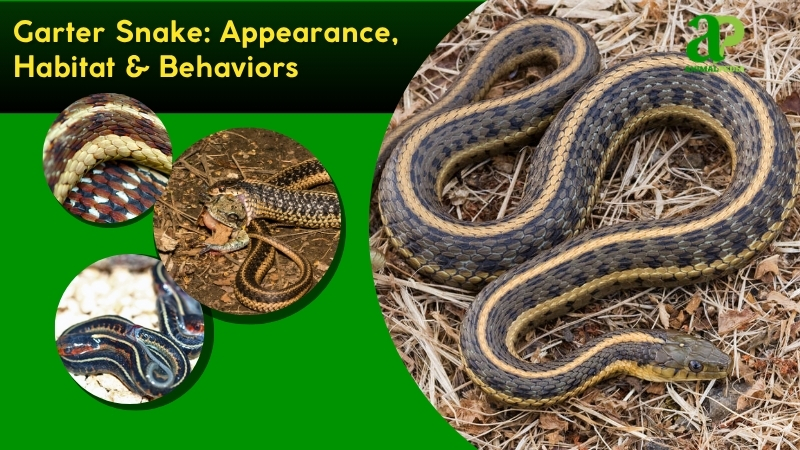
What does the Garter snake look like?
Garter snakes have slender, elongated bodies, averaging 1.5–4 feet (0.5–1.2 meters) in length. Their skin displays vibrant yellow, green, or red longitudinal stripes on dark brown or black backgrounds, with checkered patterns in some species. Smooth scales give a sleek texture, aiding swift movement through grass. The head is slightly wider than the neck, with large, round eyes for keen vision. A forked tongue flicks to sense the environment. The body tapers smoothly, lacking limbs or claws, and the tail, 20–30% of body length, is pointed.
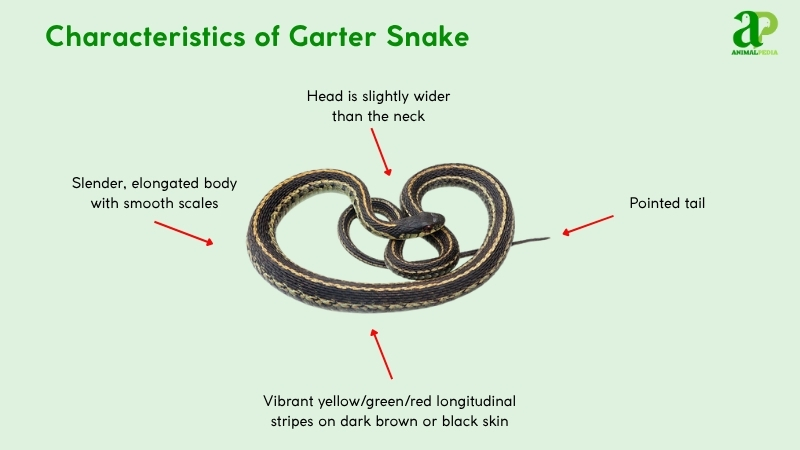
Compared to rat snakes (Pantherophis spp.), garter snakes are slimmer and have more prominent stripes, per Rossman et al. (2018). Unlike the heavier-bodied rattlesnakes (Crotalus spp.), they lack rattles and have no venomous bite. Their bright stripes and lightweight build—0.3–1 pound (0.14–0.45 kilograms)—distinguish them in North American habitats, optimizing camouflage and agility in diverse ecosystems.
How big do Garter snakes get?
Garter snakes average 1.5–4 feet (0.5–1.2 meters) in length and weigh 0.3–1 pound (0.14–0.45 kilograms). Their slender build suits agile movement.
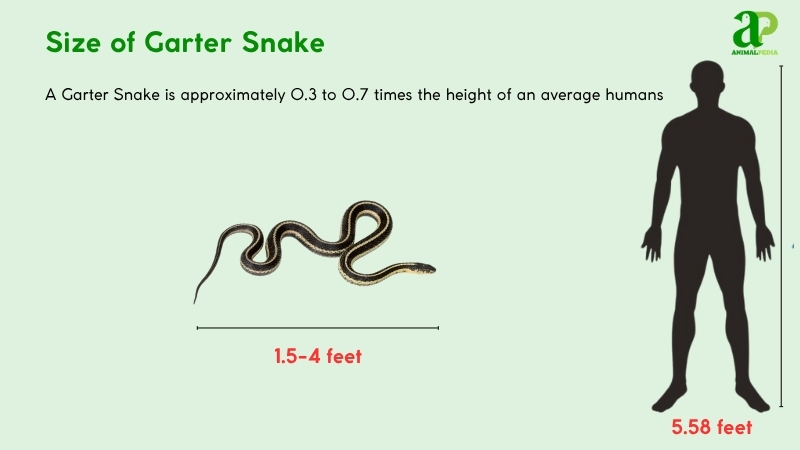
The largest recorded specimen, a Thamnophis sirtalis from Ontario in 2017, measured 4.9 feet (1.5 meters) and weighed 1.3 pounds (0.6 kilograms), per Rossman et al. (2018).
Adults typically reach 2–4 feet (0.6–1.2 meters) from snout to tail. Females are longer and heavier, averaging 3 feet (0.9 meters) and 0.8 pounds (0.36 kilograms), while males average 2.5 feet (0.76 meters) and 0.5 pounds (0.23 kilograms). Sexual dimorphism aids reproductive roles, with females’ larger size supporting live birth.
| Trait | Male | Female |
| Length | 2–3 ft (0.6–0.9 m) | 2.5–4 ft (0.76–1.2 m) |
| Weight | 0.3–0.6 lb (0.14–0.27 kg) | 0.5–1 lb (0.23–0.45 kg) |
What are the unique physical characteristics of the Garter snake?
Garter snakes are distinguished by their vibrant longitudinal stripes and exceptional adaptability to cold climates, traits rare among reptiles. These features set them apart from other snakes like rat snakes (Pantherophis spp.).
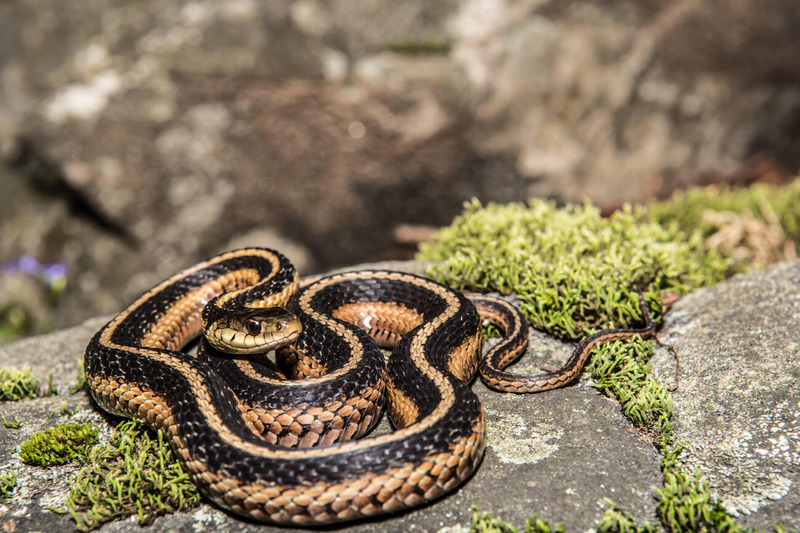
Their stripes—yellow, green, or red on dark backgrounds—span the body, enhancing camouflage in grassy habitats. Unlike most snakes, garter snakes possess a unique physiological adaptation: they produce antifreeze-like proteins in their blood, allowing activity in near-freezing temperatures, per Rossman et al. (2018).
This enables them to thrive in northern regions, from Canada to Central America. Their slender bodies, 1.5–4 feet (0.5–1.2 meters), and smooth scales facilitate rapid movement. The combination of stripes and cold tolerance, not seen in closely related colubrids, underscores their ecological versatility.
How do Garter snakes adapt with their unique features?
Garter snakes thrive across North America, leveraging vibrant stripes and cold tolerance for survival. Their stripes camouflage them in grasslands, evading predators, while antifreeze-like proteins enable activity in cold climates, per Rossman et al. (2018).
Smooth scales enhance swift slithering, aiding escape in dense vegetation. Keen eyesight detects predators, improving threat evasion. A forked tongue samples chemical cues, locating prey in varied habitats. Mild venom subdues amphibians, optimizing foraging in wetlands. These adaptations ensure garter snakes excel in diverse, often harsh environments.
Anatomy
Garter snakes possess specialized anatomical systems tailored for agility and survival in diverse North American habitats. These systems support their role as efficient, non-venomous predators, per Rossman et al. (2018).
- Respiratory System: Paired lungs with a dominant right lung ensure efficient oxygen uptake. This supports active foraging in varied terrains.
- Circulatory System: A three-chambered heart maintains low-energy circulation. It sustains prolonged activity in cold climates.
- Digestive System: A long, flexible stomach digests amphibians and insects. Mild venom aids prey breakdown, a trait shared by other amphibian-eating specialists like the Eastern Hognose Snake.
- Excretory System: Kidneys produce uric acid, conserving water. This suits dry grassland habitats.
- Nervous System: Acute vision and chemosensory tongue detect prey. The brain coordinates rapid strikes.
These systems enable garter snakes to thrive as adaptable hunters. Their anatomy reflects evolutionary solutions for navigating grasslands, wetlands, and forests, ensuring effective predation and environmental resilience.
How many types of Garter snakes are there?
Garter snakes, within the genus Thamnophis, comprise approximately 35 recognized species. Their diversity spans North America, from Canada to Central America.
Classification is based on the Linnaean system, developed by Carl Linnaeus in 1735, and refined with modern phylogenetic analysis using morphological and genetic data. This approach distinguishes species like Thamnophis sirtalis from Thamnophis elegans, per Rossman et al. (2018).
This places them in the massive Colubridae (family), a diverse group that also includes vastly different hunters, such as the high-speed Coachwhip Snake.
Order: Squamata
└── Family: Colubridae
└── Genus: Thamnophis
├── T. sirtalis – Common Garter Snake
├── T. elegans – Western Terrestrial Garter Snake
└── T. radix – Plains Garter Snake
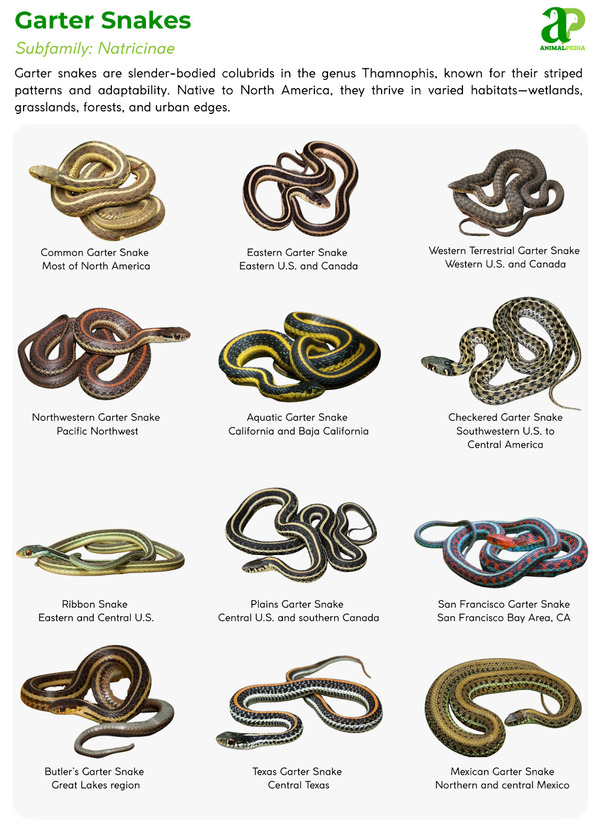
Special cases include subspecies complexes, such as T. sirtalis with 13 subspecies, showing regional variations in color and size. Hybridization between species, like T. sirtalis and T. sauritus, occurs rarely in overlapping ranges, creating identification challenges in the wild.
Where do Garter snakes live?
Garter snake habitats are distributed across North America, from Canada’s Yukon to Costa Rica, with high concentrations in the U.S. Midwest, Pacific Northwest, and southern Ontario.
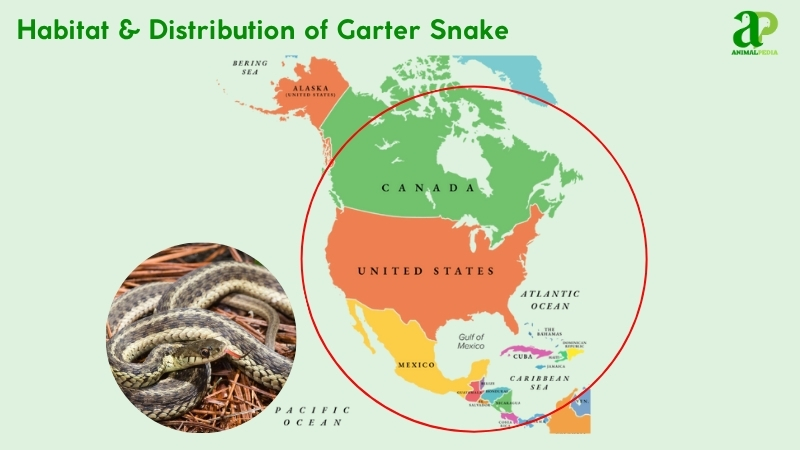
Garter snake habitats include grasslands, wetlands, forests, and suburban areas, favoring moist environments with dense vegetation. Temperatures of 68–85°F (20–29°C) and abundant Garter snake prey like amphibians make these areas ideal for their ectothermic metabolism and hunting, per Rossman et al. (2018). Cover like logs and grasses aids predator evasion.
Garter snakes have inhabited these regions for millions of years, with no significant migration. Seasonal movements to hibernation sites occur in colder areas. Their adaptability to varied climates explains their widespread presence.
How do seasonal changes affect their behavior?
Garter snakes adapt their behavior seasonally in response to shifting temperatures and prey availability across North America, as observed by Rossman et al. (2018). These changes align their activity with optimal environmental conditions, enhancing survival and reproductive success throughout the year.
- Spring/Summer (March–August): Warm temperatures boost activity; they hunt amphibians and mate actively. Daily movements increase to 0.3–0.6 miles (0.5–1 kilometer).
- Fall/Winter (September–February): Cooler weather prompts hibernation in communal dens. Feeding and movement decline, conserving energy until spring.
These seasonal adaptations optimize survival, aligning foraging and reproduction with environmental conditions in their diverse habitats.
What is the behavior of Garter snakes?
Garter snakes are highly adaptable, non-venomous colubrids found across North America. Their behaviors—shaped by diverse ecosystems—support effective feeding, mating, and survival strategies, as noted by Rossman et al. (2018).
- Feeding Habits: They hunt amphibians, insects, and worms. Mild venom aids prey capture.
- Bite & Venomous: Non-venomous, Garter snakes bite defensively. Bites are harmless to humans.
- Daily Routines and Movements: Diurnal, they move 0.3–0.6 miles (0.5–1 kilometer) daily. Activity peaks in warm months.
- Locomotion: Slithering and lateral undulation enable swift travel. Smooth scales aid grassy navigation.
- Social Structures: Mostly solitary, they gather for mating or hibernation. Communal dens host hundreds.
- Communication: Pheromones signal mating readiness. Body postures deter threats.
These behavioral traits demonstrate the garter snake’s ecological flexibility—particularly how feeding habits and locomotion enhance adaptability in changing environments.
What do Garter snakes eat?
As carnivorous, the Garter snake diet primarily includes amphibians, earthworms, and insects, with a preference for frogs and slugs. They do not attack humans; they use mild venom to subdue small prey. They swallow prey whole, with flexible jaws accommodating larger items, though oversized prey may cause regurgitation.
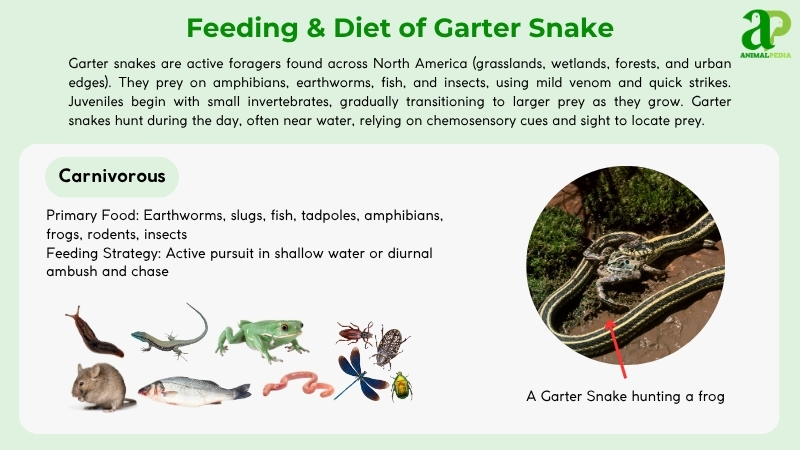
- Diet by Age:
Juvenile garter snakes begin life feeding on small, soft-bodied prey such as earthworms, slugs, and insects. Garter snake diet shifts as they grow, including amphibians like tadpoles and small frogs. This gradual transition reflects both increased jaw strength and improved hunting skill. Adult garter snakes have a more diverse and robust diet, preying on larger frogs, small fish, and even rodents when available. Their dietary progression supports rapid growth and enhances survival in varied environments.
- Diet by Gender:
There are no major differences in the Garter snake diet between male and female garter snakes. Both sexes are opportunistic carnivores that consume whatever suitable prey is most abundant in their habitat. While adult females may have slightly higher energy demands during gestation, their prey choices are similar to those of males. Garter snakes use quick strikes and mild venom to subdue prey, and both genders rely on keen chemosensory abilities to locate food efficiently.
- Diet by Seasons:
Garter snake diet changes with seasonal cycles. During spring and summer (March–August), rising temperatures and increased prey availability—especially amphibians—trigger more frequent feeding. In contrast, fall and winter (September–February) bring cooler conditions and reduced prey activity. As a result, feeding slows or ceases, particularly during hibernation. During this time, snakes rely on fat reserves built up in warmer months to survive the inactive period.
How do Garter snakes hunt their prey?
Garter snakes are skilled predators that rely on a combination of stealth, patience, and quick reflexes to catch their prey. These slender snakes have a strong sense of smell that helps them detect earthworms, insects, amphibians, and small rodents, which they hunt for food.
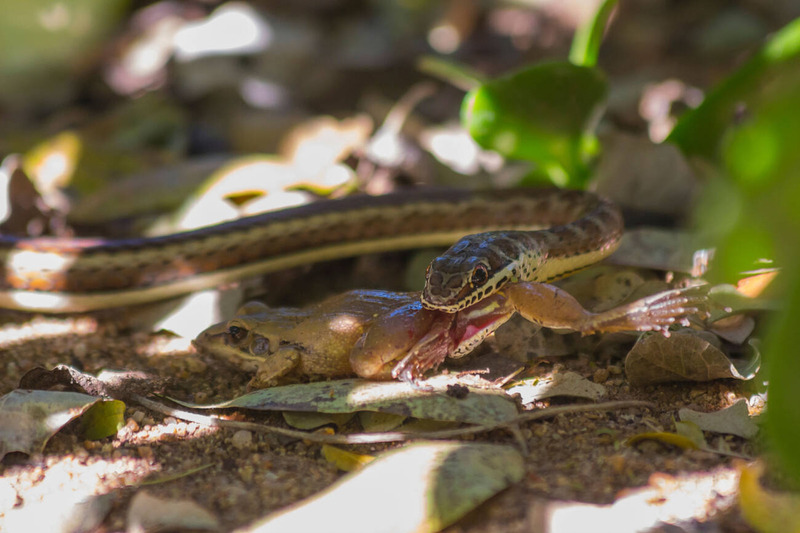
Moving with grace and using their natural camouflage to blend into their surroundings, garter snakes slowly and methodically approach their prey. When the moment is right, they strike swiftly, surprising their target with a rapid bite. Unlike venomous snakes, garter snakes use constriction to subdue their prey, demonstrating their agility and precision in hunting.
Once they capture their meal, garter snakes often swallow it whole due to their resourceful nature. These adaptable snakes can thrive in various habitats like forests, fields, gardens, and wetlands, making them successful hunters wherever they reside.
Are Garter snakes venomous?
Not all snakes have venom to immobilize their prey. Garter snakes, specifically, don’t possess venom. Instead, they depend on their speed, agility, and sharp senses to capture their prey, typically small creatures like frogs, worms, and insects. These snakes excel at hunting, utilizing their swift movements to catch their food without relying on venom.
The hunting behavior of garter snakes is intriguing to observe. They employ a technique called “creeping,” where they slowly and stealthily approach their prey before swiftly striking.
Despite lacking venom, garter snakes are formidable predators due to their hunting tactics and physical prowess. Their ability to outmaneuver and capture prey without venom showcases their impressive skills in the animal kingdom.
When are Garter snakes most active during the day?
Garter snakes are most active during the day, especially in the morning and late afternoon when the sun isn’t too intense. Garter snakes enjoy soaking up the sun’s warmth to regulate their body temperature, which makes them more active at these times.
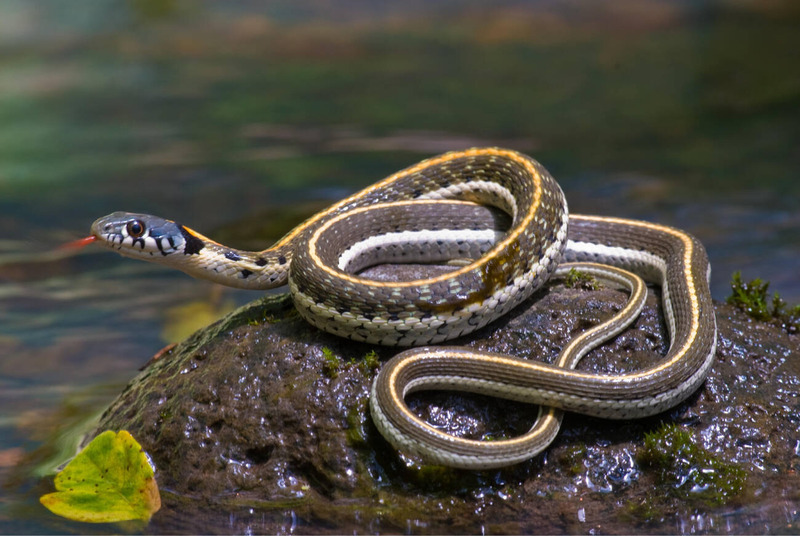
They can also be seen moving around during cooler periods, searching for food like insects, worms, frogs, and small rodents.
In the peak of summer, when temperatures are high, Garter snakes tend to be less active during the hottest part of the day. Instead, they seek shade and cooler spots to prevent overheating. However, their activity increases again in the evening as they resume hunting for food.
Keep a lookout during these times to observe these slithery hunters in action!
How do Garter snakes move on land and water?
Garter snakes are highly flexible and agile creatures, able to move effortlessly on both land and water. On land, these snakes utilize their strong muscles to slither smoothly, creating a side-to-side motion that helps them glide forward with ease. This unique way of moving allows them to navigate different types of terrain, from grassy areas to rocky paths, showcasing their adaptability in the wild.
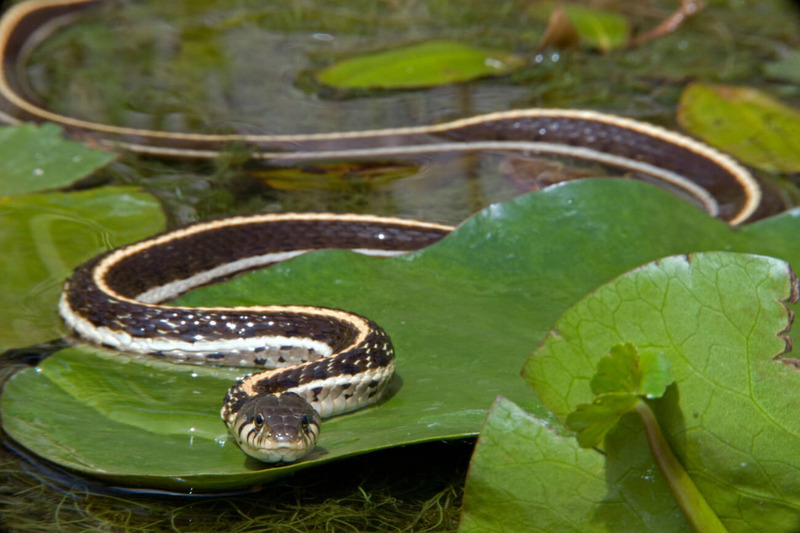
In water, Garter snakes seamlessly transition to swimming mode, using their sleek bodies to glide gracefully through ponds, streams, and marshes. Their swimming abilities demonstrate their natural prowess in aquatic environments, where they can hunt for prey or escape from predators effectively. These snakes are truly versatile, excelling in various habitats both on land and in water.
Do Garter snakes live alone or in groups?
Garter snakes typically live on their own, showing a preference for independence in their behaviors and routines. They’re solitary creatures that roam their territories freely without the need for companionship. These snakes thrive when left to their own devices, exploring their surroundings without relying on others for support or protection.
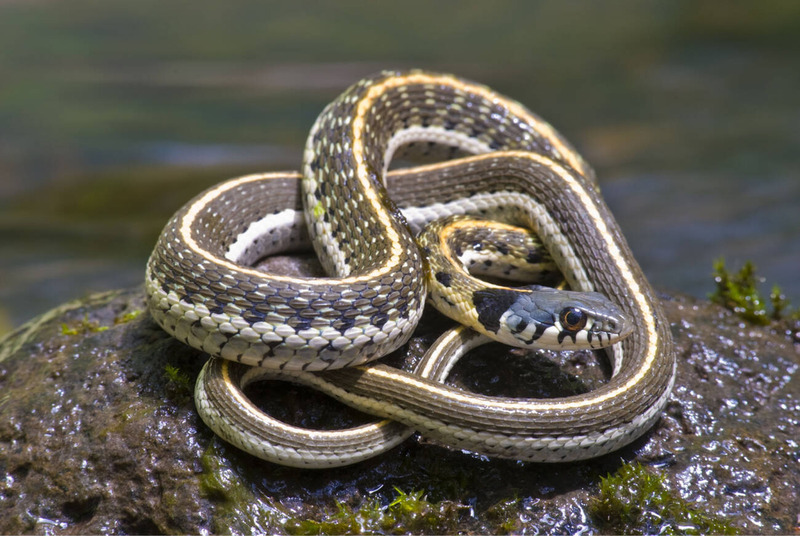
While they may occasionally be spotted sunbathing alongside fellow Garter snakes, this is more for regulating their body temperature than for socializing.
Even though they may share a sunning spot, Garter snakes don’t form social groups and are happiest when they can move and hunt independently. Whether slithering through grassy fields or hiding in rocky crevices, these reptiles excel at taking care of themselves.
Their ability to fend for themselves encompasses finding food and seeking shelter without assistance from others. In essence, Garter snakes lead fulfilling lives on their own terms, reveling in the freedom to explore their environment solo.
How do Garter snakes communicate with each other?
Garter snakes primarily rely on visual and olfactory cues to communicate with each other. They use body movements like head bobbing, tongue flicking, and body wriggling to convey messages, establish dominance, attract mates, and deter threats. Their keen sense of smell enables them to detect pheromones released by other snakes, aiding in mate selection and individual recognition.
In addition to visual and olfactory signals, Garter snakes also communicate through tail vibrations by rapidly vibrating their tails against the ground. This behavior serves as a warning to nearby snakes about potential dangers or signals readiness to mate.
Through these various forms of communication, Garter snakes navigate their social interactions and ensure their survival in the wild.
Communicating effectively is vital for these snakes to thrive in their environment by conveying important messages, signaling intentions, and maintaining social relationships within their species.
How do Garter snakes reproduce?
Garter snakes reproduce viviparously (giving birth to live young), a reproductive strategy that contrasts sharply with the egg-laying (oviparous) method of other small colubrids, like the secretive Ring-necked Snake. Breeding begins in spring (March–May), with males emerging from hibernation to form mating balls, competing to court females. Males use pheromones and chin-rubbing to flirt, aligning bodies for copulation, which lasts minutes, per Rossman et al. (2018).
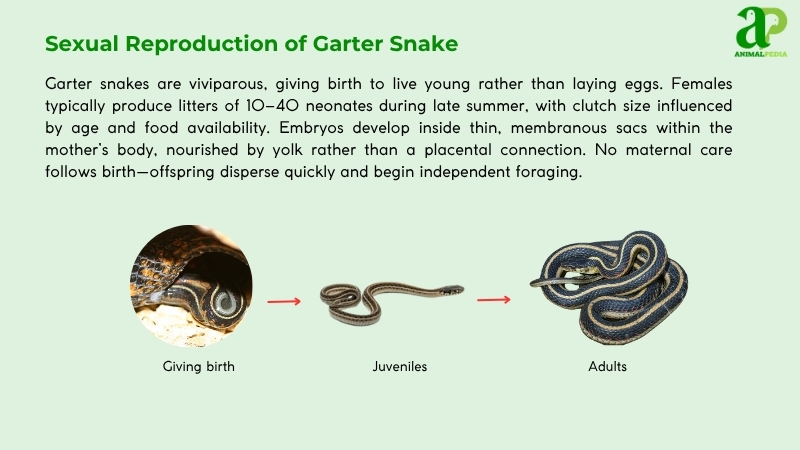
Post-mating, females gestate for 2–3 months, birthing 10–40 neonates, each 6–8 inches (15–20 centimeters) and weighing 0.04–0.07 ounces (1–2 grams). Birth occurs in secluded, moist areas like under logs; no nest is built, and females provide no protection. Males and females disperse after mating. Stress from habitat disturbance, noted in Ontario in 2017, can reduce litter sizes.
Neonates are independent, hunting small insects within days. They mature in 1–2 years. Garter snake lifespan averages 4–10 years, with females reproducing annually. Their high fecundity supports population resilience despite environmental pressures.
How long do Garter snakes live?
Garter snake lifespan is typically around 4–6 years in the wild, though some reach 8–10 years in captivity under ideal care conditions (Rossman et al., 2018). Predation, climate, and food availability significantly affect their survival.
Males generally have shorter lifespans than females due to increased energy expenditure during mating season. Female garter snakes tend to live longer and grow larger, supporting reproductive success. Lifespan variation also occurs across species and habitats, with northern populations showing slightly shorter life expectancies due to harsher winters.
What are the threats or predators that Garter snakes face today?
Garter snakes face multiple threats, primarily from human activities, with predation playing a secondary role. These pressures challenge their populations across North America.
- Habitat Loss: Urbanization and agriculture have destroyed 20% of wetland habitats since 2000, reducing foraging grounds (Rossman et al., 2018).
- Pollution: Pesticides in agricultural runoff decrease Garter snake prey availability by 15%, impacting snake health and reproduction.
- Road Mortality: Vehicle collisions kill 10–15% of local populations annually, especially in suburban areas.
- Climate Change: Warmer winters disrupt hibernation, lowering survival rates by 10% in northern ranges.
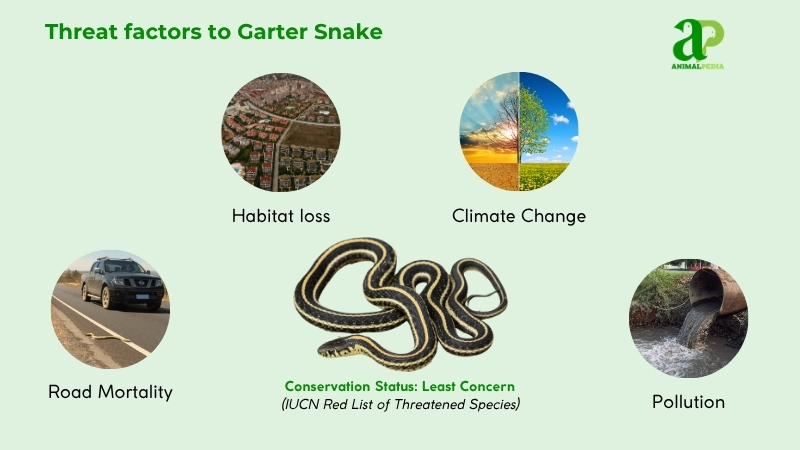
Garter snake predators in nature include birds of prey (hawks, owls), mammals (foxes, raccoons), and larger snakes, targeting juveniles and adults. Neonates are particularly vulnerable to frogs and fish.
Human impacts are significant, with urbanization and pesticide use causing a 15–20% population decline in the U.S. Midwest since 2010, per Rossman et al. (2018). Wetland drainage for development in Ontario has reduced local densities by 25%. Conservation efforts, including habitat restoration and wildlife corridors, aim to mitigate these threats, supporting garter snake resilience.
Are Garter snakes endangered?
Garter snakes are not endangered. The International Union for Conservation of Nature (IUCN) classifies most Thamnophis species, including Thamnophis sirtalis and Thamnophis elegans, as “Least Concern” due to their widespread distribution and adaptable nature across North America.
Population data is sparse, but Rossman et al. (2018) estimate millions of individuals across their range, from Canada to Central America. In the U.S. Midwest, densities average 20–50 snakes per square kilometer in optimal habitats like wetlands and grasslands. Localized declines of 15–20% have occurred in urbanized areas, such as southern Ontario, since 2010 due to habitat loss and road mortality. Their ability to thrive in disturbed environments, including suburban gardens, bolsters population stability. However, ongoing threats like pesticide use and wetland drainage require monitoring to ensure long-term resilience.
What conservation efforts are underway?
Conservation efforts for garter snakes focus on endangered subspecies, driven by habitat loss and invasive species. Key organizations like the U.S. Fish and Wildlife Service (USFWS) and Sacramento Zoo target species like the San Francisco garter snake (Thamnophis sirtalis tetrataenia) and giant garter snake (Thamnophis gigas).
Since 2014, USFWS has restored wetlands, notably at San Francisco International Airport (SFO), increasing San Francisco garter snake populations by 10% by 2024. The Sacramento Zoo monitors giant garter snakes, with habitat restoration ongoing since 2014.
The Endangered Species Act (ESA) of 1973 protects listed subspecies, prohibiting habitat destruction and illegal collection. The San Francisco garter snake, listed in 1967, and the giant garter snake, listed in 1993, benefit from these measures.
Ohio Northern University’s Plains garter snake (Thamnophis radix) program, started in 2022, released 20 neonates in 2023 at Killdeer Plains Wildlife Area. The Arizona-Sonora Desert Museum’s northern Mexican garter snake (Thamnophis eques megalops) program released 36 juveniles in 2014, with 80% survival after one year.
The SFO project transformed unused land into a thriving habitat, boosting local garter snake numbers. The Columbus Zoo’s Plains garter snake breeding has bolstered Ohio’s population, countering a 94% decline since the 1970s.
Frequently Asked Questions
Can Garter Snakes Change Their Color Like Some Other Snake Species?
Yes, garter snakes can change their color like some other snake species. This ability allows them to blend in with their surroundings for camouflage and to regulate their body temperature. It’s a cool and adaptive trait!
Do Garter Snakes Make Any Vocalizations or Sounds?
No, garter snakes do not make vocalizations or sounds. They communicate through body language and behavior. Watch closely for their tongue flicks, hisses, and movements. Enjoy observing these silent, fascinating creatures in their natural habitat.
Are Garter Snakes Commonly Kept as Pets?
Yes, garter snakes are sometimes kept as pets. They are popular due to their docile nature and manageable size. As a pet owner, you can provide a suitable habitat and diet to keep your garter snake healthy and happy.
How Do Garter Snakes Defend Themselves From Predators?
When threatened, garter snakes release a foul-smelling musk and might puff up their bodies to appear larger. Some species mimic the coloration of venomous snakes to deter predators. They’ll rattle their tail, but don’t have a rattle.
Can Garter Snakes Swim Underwater for Long Distances?
Yes, you should know that garter snakes are excellent swimmers. They can swim underwater for long distances, using their streamlined bodies to navigate effortlessly. It’s an impressive skill that helps them escape from danger.
Conclusion
In the captivating world of garter snakes, their striking appearance, diverse habitats, and intriguing behaviors set them apart. These non-venomous snakes exhibit a unique defense mechanism and can be found in various environments, making them a truly fascinating species to observe. Next time you encounter a garter snake in your garden or during a nature walk, take a moment to appreciate these fascinating reptiles and all the interesting facts you’ve learned about them. Keep exploring and cherishing the beauty of these amazing creatures in the wild!





